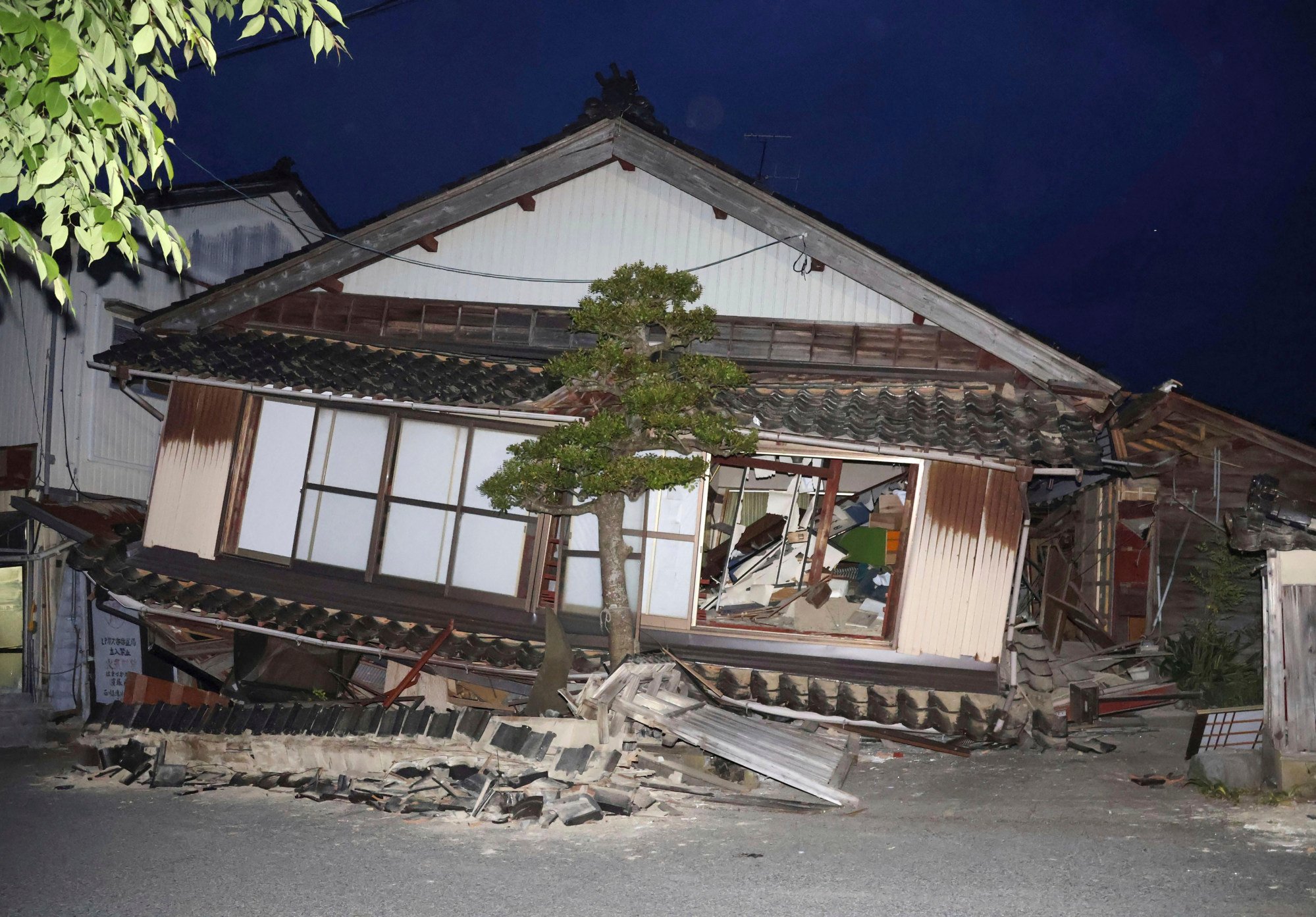- At a magnitude of 6.5, it was the largest among a series of quakes that have been hitting the Noto area since December 2020
- A 65-year-old man fell from a ladder in Suzu and was later confirmed dead, and more than 20 people have been injured

A house collapsed over a vehicle in Suzu in Ishikawa Prefecture after an earthquake rocked the region. Photo: Kyodo
An earthquake with a preliminary magnitude of 6.5 rocked Ishikawa Prefecture in central Japan and its vicinity on Friday, leaving one person dead, while some buildings collapsed and traffic and events were disrupted during the nation’s Golden Week holidays.
The quake occurred at 2.42pm, registering an upper 6 on the Japanese seismic intensity scale of 7 in Suzu, at the tip of the Noto Peninsula in the Sea of Japan coast prefecture, according to the Japan Meteorological Agency. It was the largest among a series of quakes that have been hitting the Noto area since December 2020.
No tsunami warning was issued, but a change of around 10 centimetres was detected in the sea levels in Ishikawa Prefecture, the agency said.
A 65-year-old man fell from a ladder in Suzu and was later confirmed dead, according to local authorities. The city said that over 20 people have been injured.

Aftershocks continued, with a 5.8 temblor jolting the Noto Peninsula area at about 10pm.
A man in his 30s said earlier in the day that his two-story house in Suzu was partially destroyed, although no one inside was injured. He said he was sorting through valuables as he can no longer live in the house.
“After swaying heavily sideways, there was a strong jolt in the end. I was terrified,” a 63-year-old priest of a Shinto shrine said in a phone interview. He also said two stone lanterns in front of his house collapsed.
Four Hokuriku Shinkansen services between Kanazawa and Toyama stations were suspended following the quake, while a dozen more bullet trains saw delays of 2 hours and 11 minutes at maximum, affecting a total of 8,000 people, according to West Japan Railway.
Some delayed trains included those operating between Nagano and Kanazawa stations and made emergency stops due to a temporary electrical outage.
Long lines were seen at JR Kanazawa Station due to the cancellation of train services, and some tourist spots were affected amid the Golden Week holidays that have created a travel frenzy on the back of easing coronavirus restrictions.

Shinichi Kagiya, 58, a resident of Yokohama, near Tokyo, who was waiting for a bullet train with his wife, said, “I felt the quake even when I was on a bus. I didn’t expect the final day of my retirement trip to become like this.”
At Omicho market, a popular tourist attraction in Kanazawa, Ishikawa Prefecture, quake warnings went off simultaneously on visitors’ smartphones, with a woman working at one of the stores recalling that “the shaking lasted several minutes.”
A dance event at Kanazawa Castle Park was suspended for about 30 minutes as a precaution. An organiser said that participants and visitors remained calm.
Two lifts in the 300-meter Abeno Harukas skyscraper in Osaka, Western Japan, stopped automatically after detecting seismic activity, stranding visitors on the observation decks of the 58th to 60th floors for around an hour.
All visitors were eventually able to descend safely, with no injuries reported, according to staff.

The weather agency initially reported that the earthquake was a magnitude 6.3 but later revised it to 6.5. It also said the quake originated at a depth of 10 kilometres but updated it to 12km.
The agency warned of the possibility of quakes around the upper 6 level on the Japanese seismic intensity scale for about a week in the area.
The agency defines upper 6 and 7 as “impossible to remain standing or move without crawling” and “people may be thrown through the air”.
Prime Minister Fumio Kishida, while returning to Japan from Singapore aboard a government plane, instructed his government to work with affected prefectures on rescuing disaster victims.
No abnormalities have been detected at the Shika nuclear power plant in Ishikawa Prefecture and the Kashiwazaki-Kariwa plant in nearby Niigata Prefecture.








